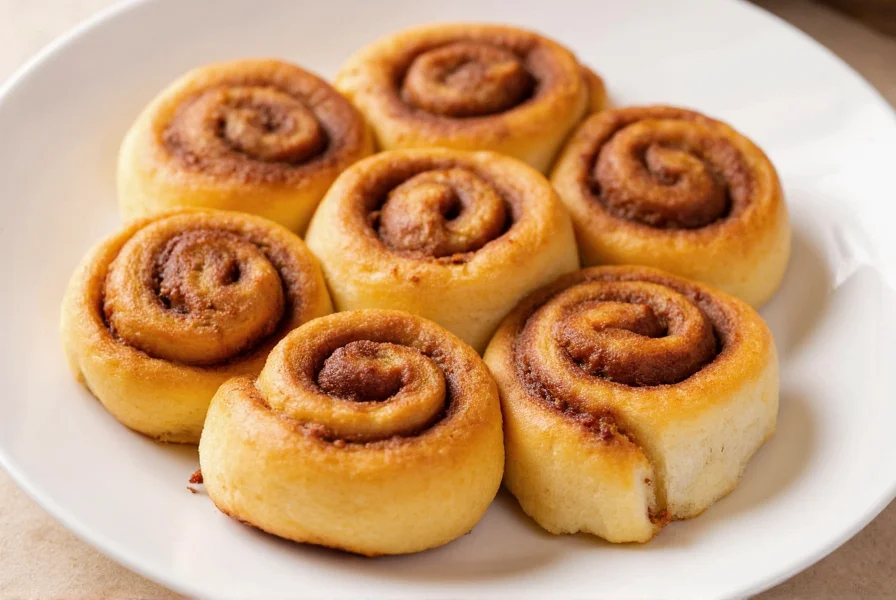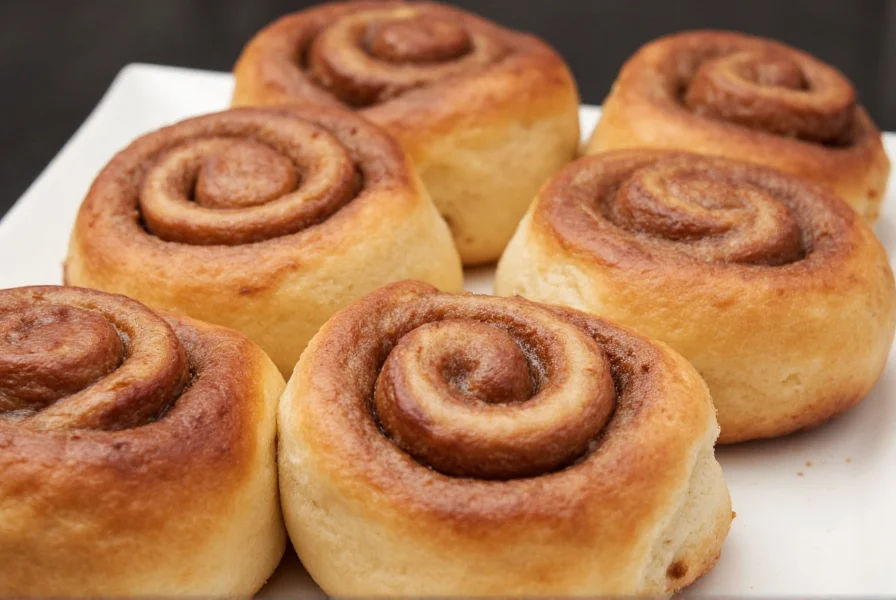Mastering homemade cinnamon rolls is achievable with the right technique and understanding of the baking science behind this beloved pastry. While many recipes exist, the difference between mediocre and exceptional cinnamon rolls lies in precise ingredient ratios, proper dough handling, and understanding the fermentation process. This guide reveals professional techniques that guarantee bakery-quality results every time, whether you're a beginner or experienced baker looking to refine your skills.
The Science Behind Perfect Cinnamon Roll Dough
Cinnamon roll dough is a enriched yeast dough that requires careful balancing of ingredients. The ideal dough contains just enough fat and sugar to create tenderness without inhibiting yeast activity. Professional bakers emphasize that water temperature is critical—too hot and you'll kill the yeast, too cold and fermentation slows dramatically. The sweet spot is 105-115°F (40-46°C), which activates yeast without damaging it.
Flour measurement significantly impacts texture. Spoon flour into your measuring cup and level it off—don't scoop directly from the bag, which compacts the flour and leads to dry, dense rolls. For consistent results, consider weighing your flour (120-125g per cup). The dough should feel smooth and slightly tacky but not sticky after kneading—this indicates proper gluten development without overworking.
| Ingredient | Function | Professional Tip |
|---|---|---|
| Yeast | Leavening agent | Use instant yeast for more reliable activation; proof active dry yeast first |
| Butter | Tenderness and flavor | Room temperature for even distribution; cold creates pockets |
| Sugar | Feeds yeast, caramelization | Brown sugar in filling creates richer flavor and better swirl |
| Eggs | Structure and richness | Room temperature prevents dough temperature fluctuations |
Essential Equipment for Consistent Results
While you can make cinnamon rolls with basic kitchen tools, certain equipment significantly improves consistency. A stand mixer with dough hook attachment ensures even kneading without overworking the dough. A digital thermometer verifies proper water temperature for yeast activation. A bench scraper helps handle sticky dough without adding excess flour. For precise filling distribution, an offset spatula spreads butter evenly without tearing the dough.
Rolling pin quality matters more than many realize—a smooth, heavy rolling pin creates even pressure for consistent thickness. Professional bakers recommend a thickness of ¼ inch for the rolled dough; thinner creates fragile rolls that collapse, thicker prevents proper swirl formation. A sharp serrated knife or unflavored dental floss cleanly cuts rolls without compressing the edges.

Step-by-Step Cinnamon Roll Perfection
Dough preparation: Combine warm milk, sugar, and yeast, letting it sit for 5-10 minutes until foamy. In a stand mixer, combine flour, melted butter, eggs, and yeast mixture. Mix on low until combined, then knead with dough hook for 5-7 minutes until smooth and elastic. The windowpane test confirms proper gluten development—stretch a small piece of dough; it should form a translucent membrane without tearing.
First rise: Place dough in a lightly greased bowl, cover with plastic wrap, and let rise at room temperature until doubled (1-1.5 hours). Avoid rushing this step—proper fermentation develops flavor. For more complex flavor, refrigerate overnight for a slow, cold fermentation.
Filling application: Roll dough into a 16x12 inch rectangle. Spread softened butter evenly, leaving a ½ inch border. Mix brown sugar, cinnamon, and a pinch of salt—this salt enhances flavor without making it salty. Sprinkle evenly over butter. For extra flavor dimension, add finely chopped pecans or a tablespoon of espresso powder to the filling.
Rolling technique: Starting from the long edge, roll dough tightly but gently. Pinch the seam to seal. Using a sharp knife or dental floss, cut into 12 equal pieces. Place in a greased 9x13 inch pan with space between rolls for proper expansion during second rise.
Final proof and baking: Cover and let rise until nearly doubled (45-60 minutes). Bake at 350°F (175°C) for 22-28 minutes until golden brown. The rolls are done when internal temperature reaches 190°F (88°C). Overbaking creates dry rolls—err on the side of underdone as they continue cooking slightly out of the oven.
Common Cinnamon Roll Problems and Solutions
Dense, heavy rolls: Usually caused by too much flour, killed yeast, or insufficient rising time. Measure flour properly and verify yeast is active. Allow full rise time—even if dough doesn't quite double, it needs proper fermentation.
Filling leaking out: Results from uneven butter layer, too much filling, or rolling too loosely. Use room-temperature butter for even spreading, and don't overfill. Roll tightly but gently to avoid tearing.
Hard crust: Often from overbaking or improper cooling. Remove rolls from oven when golden but still soft to touch. Cover with a clean kitchen towel immediately after glazing to retain moisture.
Rolls sticking to pan: Use proper greasing technique—butter or shortening works better than cooking spray. For guaranteed release, line pan with parchment paper.

Storage and Reheating for Maximum Freshness
For best texture, consume cinnamon rolls within 24 hours. Store cooled rolls in an airtight container at room temperature—refrigeration dries them out. To refresh day-old rolls, microwave for 10-15 seconds or warm in a 300°F (150°C) oven for 5 minutes. For longer storage, freeze unglazed rolls after second rise: place on parchment-lined baking sheet, freeze solid, then transfer to freezer bags. Bake from frozen, adding 5-8 minutes to baking time.
Popular Cinnamon Roll Variations
Cream cheese frosting: The classic pairing—beat softened cream cheese with butter, powdered sugar, vanilla, and a pinch of salt until smooth. Add milk one tablespoon at a time for desired consistency.
Sticky buns: Place chopped pecans and a brown sugar-butter mixture in the bottom of the pan before adding rolls. When inverted after baking, this creates a caramelized topping.
Whole wheat option: Substitute up to 50% of the all-purpose flour with white whole wheat flour for added nutrition without sacrificing texture.
Gluten-free version: Use a quality gluten-free flour blend with xanthan gum. Increase liquid slightly as GF flours absorb more moisture. Let dough rest 10 minutes after mixing to allow flours to hydrate fully.
Frequently Asked Questions
Can I make cinnamon rolls ahead of time?
Yes, prepare rolls through the second rise, then cover and refrigerate overnight. Remove from refrigerator 1-2 hours before baking to allow proper rising. Alternatively, freeze unbaked rolls after the second rise, then thaw and rise in the refrigerator overnight before baking.
Why did my cinnamon rolls collapse after baking?
Collapse usually occurs from over-rising before baking. The yeast exhausts its food supply, causing the structure to weaken. Rolls should double in size during the second rise—not triple. Also, avoid opening the oven door during the first 15 minutes of baking, as temperature fluctuations can cause collapse.
How can I make my cinnamon rolls softer?
For softer rolls, increase the fat content slightly by adding 1-2 tablespoons of additional butter to the dough. Ensure proper baking time—overbaking dries them out. Brushing baked rolls with melted butter before adding frosting also helps retain moisture. Using bread flour instead of all-purpose flour creates a more tender crumb due to its higher protein content.
What's the difference between cinnamon rolls and cinnamon buns?
Cinnamon rolls typically have a softer, more bread-like texture with a spiral filling throughout the roll. Cinnamon buns often feature a denser, cake-like texture with the filling concentrated in the center. Buns frequently include nuts in the filling and are served with a harder icing that sets rather than a pourable glaze.











 浙公网安备
33010002000092号
浙公网安备
33010002000092号 浙B2-20120091-4
浙B2-20120091-4